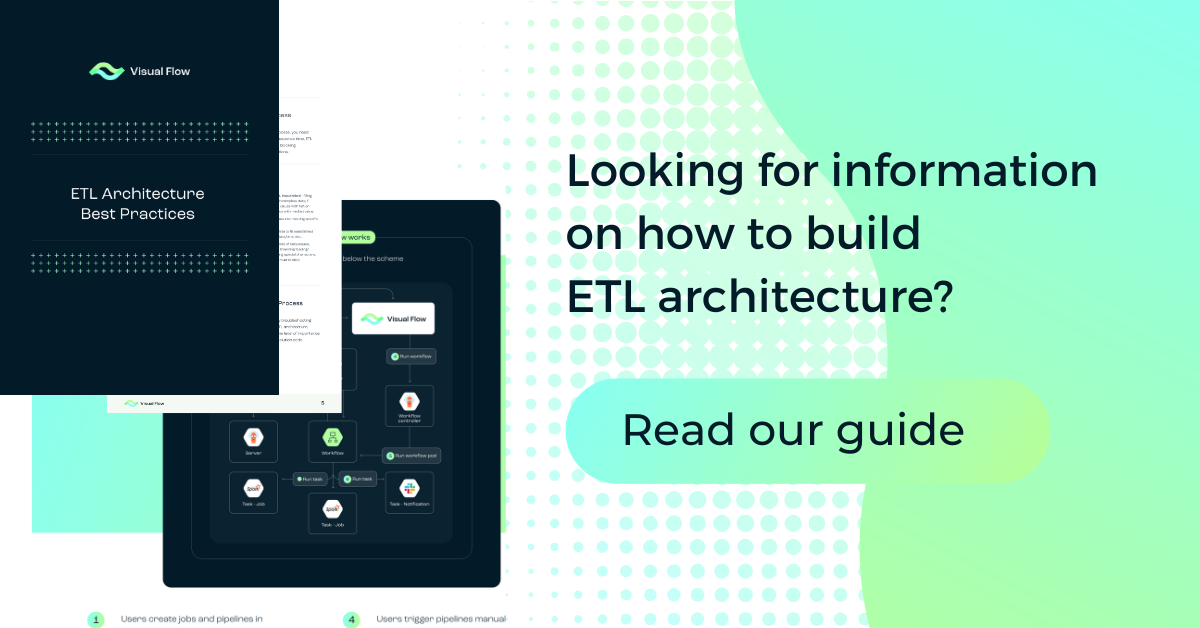Table of Content:
Table of Content:


Today businesses heavily rely on cloud services to store enormous amounts of data. The ever-growing demand to keep all kinds of information on platforms like Amazon Web Services (AWS) calls for new solutions, exactly when ETL tools kick in. Meaning “Extract, Transform, and Load”, ETL instruments provide a cloud warehouse for safe data management. Considering the complexity of the subject, choosing the right ETL service is quite a challenge we shall transcend in this article, so buckle up and let’s go!
What is AWS ETL Tools?
AWS ETL instruments exist not only as a space for keeping data. They also carry the management purpose, and this aspect shouldn’t be overlooked when choosing the best ETL tool to meet your needs. As the name suggests, the algorithm of working with ETL services consists of extracting data from the sources (they can be relational databases, flat files, APIs, or cloud apps), transforming it according to the business desires, and further loading it into the target, which is typically a data warehouse in the AWS cloud environment. As an example, a company can extract sales data from multiple regional databases, process it within the needed format, and then load it into a centralized Amazon Redshift data warehouse for further usage. Completion of these steps creates a smooth data pipeline for healthy business intelligence. However, there are two kinds of ETL instruments: native and third-party. Let’s take a closer look at them.
AWS Native ETL Services
AWS has its own ETL services designed in absolute compatibility to provide seamless data integration into its environment. The one we should begin with is AWS Glue which is a fully managed ETL resource for fully automated data exploration. Having a vast transformation functionality, AWS Glue allows users to clean, filter, and process data for further loading it into target storages like Amazon S3, Amazon Redshift, Amazon RDS, etc.
Organizations that already use AWS tools usually find AWS Glue especially attractive due to its seamless integration with other AWS products.
The ETL is serverless which means that users don’t have to operate the infrastructure themselves and it adjusts to growing data flow automatically. Furthermore, AWS Glue comes with a built-in data catalog functionality that works with the metadata of the company’s environment. We will explore this instrument more later in the article, but now there is one more type of AEW ETL service to mention.
Third-Party AWS ETL Tools
As a powerful native solution as AWS Glue is, not every company will find it particularly what they were looking for. Having to work with several cloud platforms or external data systems emphasizes the need for extra solutions. And this is when third-party ETL tools come in handy. Many leading ETL platforms, such as Talend, Fivetran, Matillion, and Stitch, offer built-in Amazon connectors that enable seamless integration with AWS services like Amazon S3, Amazon Redshift, and AWS Lambda.
Third-party instruments usually offer additional features, such as bigger support for non-AWS data sources, broader data transformation functionality, or a more ergonomic and intuitive user interface to make the data pipeline work smoother. The user may want to try a tool like Matillion to connect to on-premises databases, transform data within AWS, and finally load it into data storage on Amazon Redshift. Such platforms typically have built-in connectors for other cloud services like Azure, Snowflake, Google Cloud, etc.
Limitations of Native AWS ETL Tools
Probably every tool, no matter how usable and powerful it is, has its limitations, and so do Native ETL instruments, including AWS Glue:
- Not beginner-friendly. Setting up native tools without enough knowledge of how the AWS environment works can be quite tricky.
- Built-in connectors limitations. Even though natives such as AWS Glue are compatible with popular AWS data sources, they have limited connectors for external systems. This puts companies in front of the need to build custom integrations which complexes the work not in a good way.
- Expensive workloads. The cost of using AWS ETL tools grows with data volumes, especially for complex or frequent data pipelines.
Also, many advanced users will find native services lacking functionality to fine-tune the system to their needs.
Key Factors for Selecting the Right AWS ETL Tool
When choosing your AWS ETL instrument you have to weigh several factors, and these have proven to be the most critical of them:
- Supported data sources and connectors.
Whether the instrument supports a large number of data sources is one of the first things to check. Aim towards a platform that has various connectors to popular databases, APIs, apps, and cloud platforms like Azure, Google Cloud, etc. The wider the connectivity is, the easier it will be to integrate data from various systems. Check the guide on ETL with Azure to discover how ETL tools integrate with Azure.
- User-friendliness and automation.
Some tools have more intuitive interfaces, introducing simple mechanics like drag-n-drop, while others heavily rely on coding and high infrastructure management capabilities. It’s usually up to the technical level of your team but it’s one of the first aspects to check.
- Performance and scalability.
The data will constantly be expanding, so your ETL tool should be able to scale along with it. Make sure your instrument won’t collapse under ever-growing loads of data. Cloud-native ETL tools are generally more capable of scaling in line with increasing data needs.
- Cost-effectiveness.
Study the pricing model of each tool and don’t forget that native AWS instruments include computing and data storage usage in the price count. Consider third-party tools with transparent pricing models and flexible options, including pay-as-you-go plans. ETL consulting services are available if you need to optimize your costs. Here you can learn more about ETL migration services.
- Data transformation capabilities.
Different ETL tools offer varying degrees of flexibility in data transformation. Consider tools that offer a wide range of transformation functions, from simple formatting to complex calculations, aggregations, and machine learning capabilities.
- Security.
Business data is quite a sensitive matter and thereby requires solid security. Consider those ETL platforms that offer firm encryption, access verification, and compliance certifications, like GDPR, HIPAA, SOC 2, etc, to make sure that your data handling is safe.
- Support.
Your experience of using an ETL service may be ruined just by a lack of support or documentation. While making your choice, make sure that the picked instrument has guides and tutorials, as well as responsive support to answer any of your inquiries regarding the service.
How to Streamline Your Data Integration with AWS ETL
You will need to use the right combination of tools and techniques to streamline your data integration as smoothly as possible. Here are some healthy tips on how to achieve seamless optimization of your AWS ETL pipeline:
- Automate data workflows.
Operating an ETL tool can be a cumbersome journey, and good automation can be a huge relief. Apply scheduling instruments or add automated triggers to your platform and take off the need to constantly intervene in the processes yourself. For instance, AWS Glue allows setting up automated tasks that trigger when certain conditions are met.
- Optimize resource allocation.
Efficient resource usage ensures your ETL jobs run smoothly and cost-effectively. Use cloud-native ETL tools that dynamically allocate resources based on job requirements to prevent overspending.
- Integrate multiple data sources.
The more diverse your data sources, the more complicated your integration process can become. Choose a tool that supports the various systems, databases, and applications used by your organization. Tools that support Snowflake ETL workflows offer strong integration capabilities.
- Monitor and troubleshoot data pipelines.
Monitoring tools within your ETL platform can help you identify bottlenecks and failures. This is critical for ensuring smooth data processing. Many tools offer real-time monitoring features to quickly address issues.
Top AWS ETL Tools for Different Business Needs
Choosing an ETL tool for your AWS space relies on various factors, such as the size of your business, your needs regarding data processing, and available resources. Here are some popular instruments to pick from:
- AWS Glue.
AWS Glue is a fully managed ETL service that allows you to automate your data setup and integration workflows. It is perfect for businesses that are already heavily invested in the AWS ecosystem.
- Talend.
Talend offers a cloud-based ETL platform with strong AWS integration. It comes with built-in connectors for popular data sources and apps, which makes Talend ideal for companies that need a flexible solution for integration in multiple systems.
- Matillion.
Another popular instrument with businesses that use AWS. First of all, this is due to its simplicity combined with powerful data transformation capabilities. Matillion is also well-suited for data integration into Amazon Redshift or Snowflake.
- Stitch.
Stitch is a lightweight ETL tool that is satisfyingly easy to use. It is designed for small and medium-sized businesses and offers a wide range of data connectors. Combined with the user-friendly interface, Stitch poses a perfect solution for teams that prefer simplicity.
- Fivetran.
Not only Fivetran offers automated data pipeline mechanics, but provides extensive connector support as well which makes it suitable for companies with diverse data ecosystems. Fivetran ensures low-maintenance pipelines that smoothly integrate with AWS.
Having an arsenal of factors to look for and a list of possible ETL tools, you should be able to find the most reliable one for your business.
AWS ETL tools automate the data extracting, transformation, and loading processes, completing these tasks in just a few minutes. They also optimize ETL pipeline orchestration.
We have listed the best ETL tools for AWS above in our article (they are: Visual Flow, Integrate.io, AWS Glue, Datastage, Databricks, Upsolver, Talend, AWS Kinesis, AWS Data Pipeline, and Hevo). However, picking a particular one depends on your business needs and the characteristics of your network infrastructure.
When choosing the best AWS ETL tools, make sure that they effectively perform their main task — extract, transform, and load the data. Also, the AWS ETL tool you pick should be cost-effective, easy to install and use, and guarantee the security of all data manipulations.
Contact us































































